PEUGEOT 308 2016 Owners Manual
Manufacturer: PEUGEOT, Model Year: 2016, Model line: 308, Model: Peugeot 308 2016Pages: 344, PDF Size: 12.23 MB
Page 111 of 344
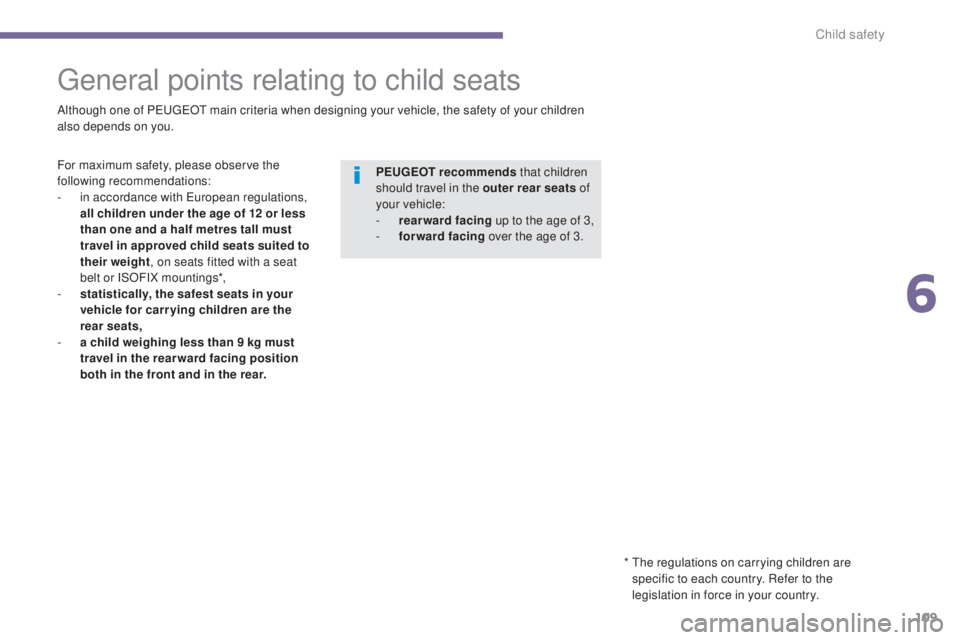
109
3008_en_Chap06_securite-enfants_ed01-2015
General points relating to child seats
Although one of PEUGEOT main criteria when designing your vehicle, the safety of your children
also depends on you.*
T
he regulations on carrying children are
specific to each country. Refer to the
legislation in force in your country.
For maximum safety, please observe the
following recommendations:
-
i
n accordance with European regulations,
all children under the age of 12 or less
than one and a half metres tall must
travel in approved child seats suited to
their weight , on seats fitted with a seat
belt or ISOFIX mountings*,
-
s
tatistically, the safest seats in your
vehicle for carr ying children are the
rear seats,
-
a c
hild weighing less than 9 kg must
travel in the rearward facing position
both in the front and in the rear. PEUGEOT recommends
that children
should travel in the outer rear seats of
your vehicle:
-
re
arward facing up to the age of 3,
-
fo
rward facing over the age of 3.
6
Child safety
Page 112 of 344
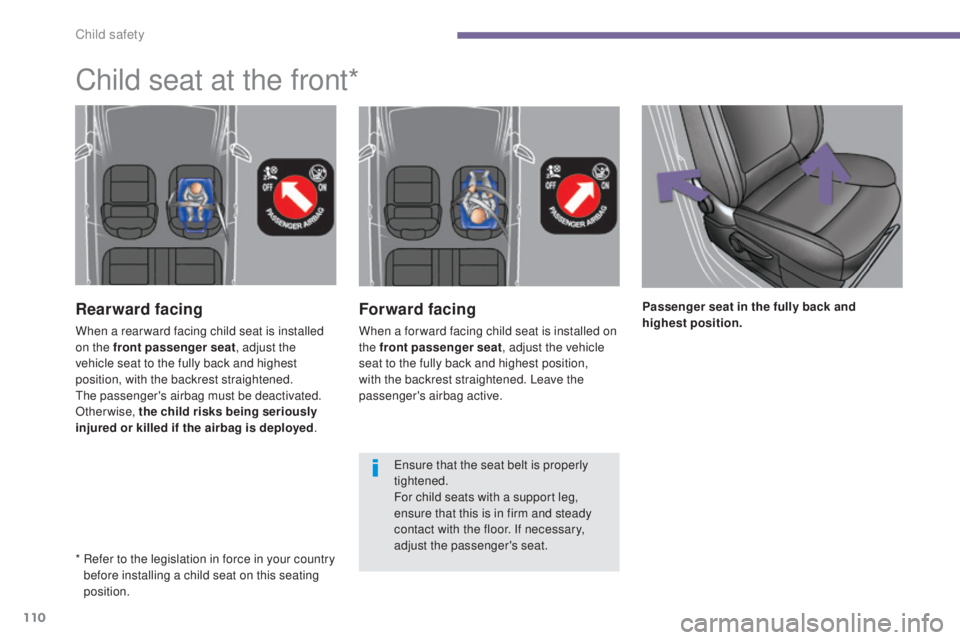
110
3008_en_Chap06_securite-enfants_ed01-2015
Forward facing
When a for ward facing child seat is installed on
the front passenger seat, adjust the vehicle
seat to the fully back and highest position,
with the backrest straightened. Leave the
passenger's airbag active.
Rearward facing
When a rear ward facing child seat is installed
on the front passenger seat , adjust the
vehicle seat to the fully back and highest
position, with the backrest straightened.
The passenger's airbag must be deactivated.
Otherwise, the child risks being seriously
injured or killed if the airbag is deployed .
Child seat at the front*
Ensure that the seat belt is properly
tightened.
For child seats with a support leg,
ensure that this is in firm and steady
contact with the floor. If necessary,
adjust the passenger's seat. Passenger seat in the fully back and
highest position.
*
R
efer to the legislation in force in your country
before installing a child seat on this seating
position.
Child safety
Page 113 of 344
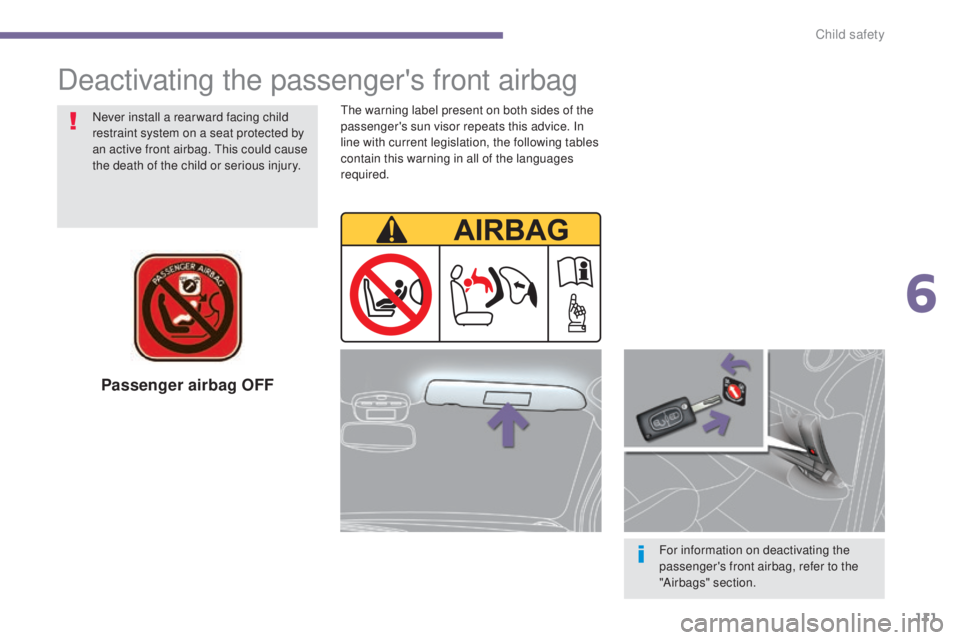
111
3008_en_Chap06_securite-enfants_ed01-2015
Passenger airbag OFF
For information on deactivating the
passenger's front airbag, refer to the
"Airbags" section.
Never install a rear ward facing child
restraint system on a seat protected by
an active front airbag. This could cause
the death of the child or serious injury.
Deactivating the passenger's front airbag
The warning label present on both sides of the
passenger's sun visor repeats this advice. In
line with current legislation, the following tables
contain this warning in all of the languages
required.
6
Child safety
Page 114 of 344
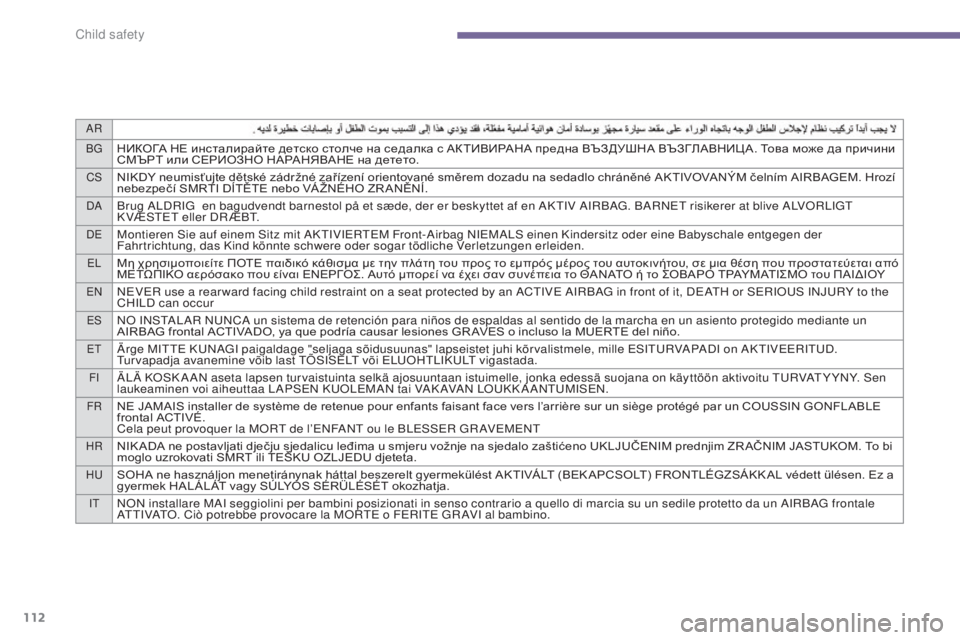
AR
BG
НИКОГА НЕ инсталирайте детско столче на седалка с АКТИВИРАНА предна ВЪЗДУШНА ВЪЗГЛАВНИЦ А. Това може да причини
СМЪРТ или СЕРИОЗНО НАРАНЯВАНЕ на детето.
CSNIKDY neumisťujte dětské zádržné zařízení orientované směrem dozadu na sedadlo chráněné AKTIVOVANÝM čelním AIRBAGEM. Hrozí
nebezpečí SMRTI DÍTĚTE nebo VÁ ŽNÉHO ZR ANĚNÍ.
DABrug ALDRIG en bagudvendt barnestol på et sæde, der er beskyttet af en AKTIV AIRBAG. BARNET risikerer at blive ALVORLIGT
K VÆSTET eller DR ÆBT.
DEMontieren Sie auf einem Sitz mit AKTIVIERTEM Front-Airbag NIEMALS einen Kindersitz oder eine Babyschale entgegen der
Fahrtrichtung, das Kind könnte schwere oder sogar tödliche Verletzungen erleiden.
ELΜη χρησιμοποιείτε ΠΟΤΕ παιδικό κάθισμα με την πλάτη του προς το εμπρός μέρος του αυτοκινήτου, σε μια θέση που προστατεύεται από
ΜΕΤΩΠΙΚΟ αερόσακο που είναι ΕΝΕΡΓΟΣ. Αυτό μπορεί να έχει σαν συνέπεια το ΘΑΝΑΤΟ ή το ΣΟΒΑΡΟ ΤΡΑΥΜΑΤΙΣΜΟ του ΠΑΙΔΙΟΥ
ENNEVER use a rear ward facing child restraint on a seat protected by an ACTIVE AIRBAG in front of it, DEATH or SERIOUS INJURY to the
CHILD can occur
ESNO INSTALAR NUNCA un sistema de retención para niños de espaldas al sentido de la marcha en un asiento protegido mediante un
AIRBAG frontal ACTIVADO, ya que podría causar lesiones GR AVES o incluso la MUERTE del niño.
ETÄrge MITTE KUNAGI paigaldage "seljaga sõidusuunas" lapseistet juhi kõrvalistmele, mille ESITURVAPADI on AKTIVEERITUD.
Tur vapadja avanemine võib last TÕSISELT või ELUOHTLIKULT vigastada.
FIÄLÄ KOSK A AN aseta lapsen tur vaistuinta selkä ajosuuntaan istuimelle, jonka edessä suojana on käyttöön aktivoitu TURVAT Y YNY. Sen
laukeaminen voi aiheuttaa LAPSEN KUOLEMAN tai VAK AVAN LOUKK A ANTUMISEN.
FRNE JAMAIS installer de système de retenue pour enfants faisant face vers l’arrière sur un siège protégé par un COUSSIN GONFLABLE
frontal ACTIVÉ.
Cela peut provoquer la MORT de l’ENFANT ou le BLESSER GR AVEMENT
HRNIK ADA ne postavljati dječju sjedalicu leđima u smjeru vožnje na sjedalo zaštićeno UKLJUČENIM prednjim ZR AČNIM JASTUKOM. To bi
moglo uzrokovati SMRT ili TEŠKU OZLJEDU djeteta.
HUSOHA ne használjon menetiránynak háttal beszerelt gyermekülést AKTIVÁLT (BEK APCSOLT) FRONTLÉGZSÁKK AL védett ülésen. Ez a
gyermek HALÁLÁT vagy SÚLYOS SÉRÜLÉSÉT okozhatja.
ITNON installare MAI seggiolini per bambini posizionati in senso contrario a quello di marcia su un sedile protetto da un AIRBAG frontale
ATTIVATO. Ciò potrebbe provocare la MORTE o FERITE GR AVI al bambino.
112
3008_en_Chap06_securite-enfants_ed01-2015
Child safety
Page 115 of 344
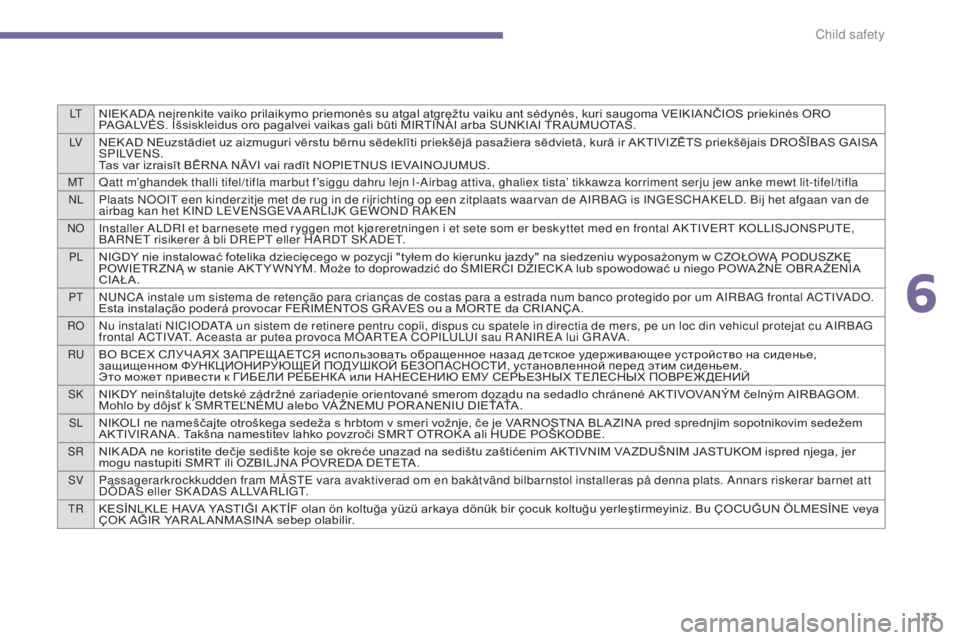
LTNIEK ADA neįrenkite vaiko prilaikymo priemonės su atgal atgręžtu vaiku ant sėdynės, kuri saugoma VEIKIANČIOS priekinės ORO
PAGALVĖS. Išsiskleidus oro pagalvei vaikas gali būti MIRTINAI arba SUNKIAI TR AUMUOTAS.
LVNEK AD NEuzstādiet uz aizmuguri vērstu bērnu sēdeklīti priekšējā pasažiera sēdvietā, kurā ir AKTIVIZĒTS priekšējais DROŠĪBAS GAISA
S P I LV E N S .
Tas var izraisīt BĒRNA NĀVI vai radīt NOPIETNUS IEVAINOJUMUS.
MTQatt m’ghandek thalli tifel/tifla marbut f’siggu dahru lejn l-Airbag attiva, ghaliex tista’ tikkawza korriment serju jew anke mewt lit-tifel/tifla
NLPlaats NOOIT een kinderzitje met de rug in de rijrichting op een zitplaats waar van de AIRBAG is INGESCHAKELD. Bij het afgaan van de
airbag kan het KIND LEVENSGEVA ARLIJK GEWOND R AKEN
NOInstaller ALDRI et barnesete med ryggen mot kjøreretningen i et sete som er beskyttet med en frontal AKTIVERT KOLLISJONSPUTE,
BARNET risikerer å bli DREPT eller HARDT SK ADET.
PLNIGDY nie instalować fotelika dziecięcego w pozycji "tyłem do kierunku jazdy" na siedzeniu wyposażonym w CZOŁOWĄ PODUSZKĘ
POWIETR ZNĄ w stanie AKT Y WNYM. Może to doprowadzić do ŚMIERCI DZIECK A lub spowodować u niego POWA ŻNE OBR A ŻENIA
CIAŁA.
PTNUNCA instale um sistema de retenção para crianças de costas para a estrada num banco protegido por um AIRBAG frontal ACTIVADO.
Esta instalação poderá provocar FERIMENTOS GR AVES ou a MORTE da CRIANÇA.
RONu instalati NICIODATA un sistem de retinere pentru copii, dispus cu spatele in directia de mers, pe un loc din vehicul protejat cu AIRBAG
frontal ACTIVAT. Aceasta ar putea provoca MOARTEA COPILULUI sau R ANIREA lui GR AVA.
RUВО ВСЕХ СЛУЧА ЯХ ЗАПРЕЩАЕТСЯ использовать обращенное назад детское удерживающее устройство на сиденье,
защищенном ФУНКЦИОНИРУЮЩЕЙ ПОДУШКОЙ БЕЗОПАСНОСТИ, установленной перед этим сиденьем.
Это может привести к ГИБЕЛИ РЕБЕНК А или НАНЕСЕНИЮ ЕМУ СЕРЬЕЗНЫХ ТЕЛЕСНЫХ ПОВРЕЖ ДЕНИЙ
SKNIKDY neinštalujte detské zádržné zariadenie orientované smerom dozadu na sedadlo chránené AKTIVOVANÝM čelným AIRBAGOM.
Mohlo by dôjsť k SMRTEĽNÉMU alebo VÁ ŽNEMU POR ANENIU DIEŤAŤA.
SLNIKOLI ne nameščajte otroškega sedeža s hrbtom v smeri vožnje, če je VARNOSTNA BLA ZINA pred sprednjim sopotnikovim sedežem
AKTIVIR ANA. Takšna namestitev lahko povzroči SMRT OTROK A ali HUDE POŠKODBE.
SRNIK ADA ne koristite dečje sedište koje se okreće unazad na sedištu zaštićenim AKTIVNIM VA ZDUŠNIM JASTUKOM ispred njega, jer
mogu nastupiti SMRT ili OZBILJNA POVREDA DETETA.
SVPassagerarkrockkudden fram MÅSTE vara avaktiverad om en bakåtvänd bilbarnstol installeras på denna plats. Annars riskerar barnet att
DÖDAS eller SK ADAS ALLVARLIGT.
TRKESİNLKLE HAVA YASTIĞI AKTİF olan ön koltuğa yüzü arkaya dönük bir çocuk koltuğu yerleştirmeyiniz. Bu ÇOCUĞUN ÖLMESİNE veya
ÇOK AĞIR YAR ALANMASINA sebep olabilir.
113
3008_en_Chap06_securite-enfants_ed01-2015
6
Child safety
Page 116 of 344
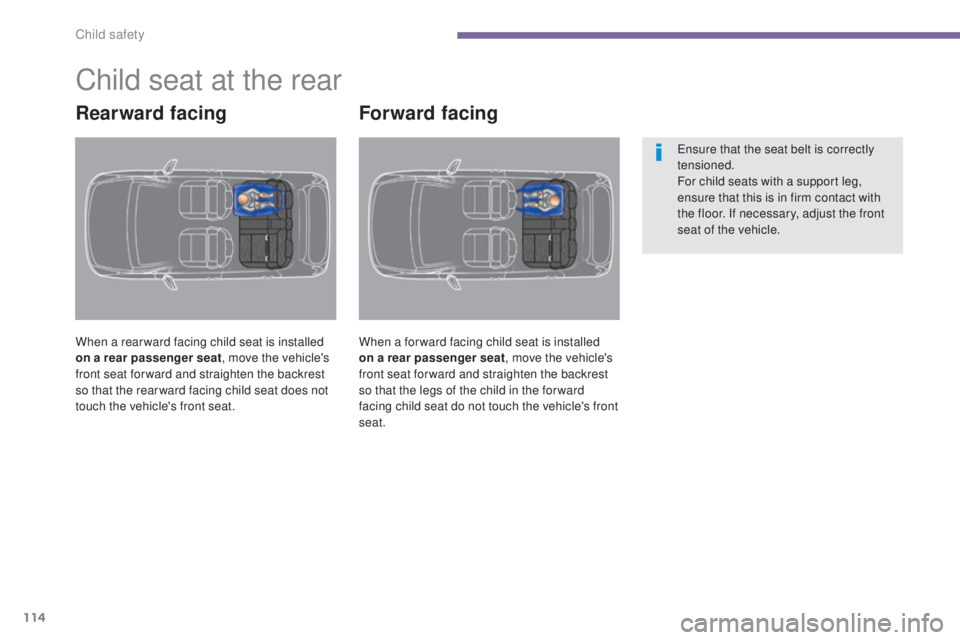
114
3008_en_Chap06_securite-enfants_ed01-2015
Child seat at the rear
Rearward facing
When a rear ward facing child seat is installed
on a rear passenger seat, move the vehicle's
front seat for ward and straighten the backrest
so that the rear ward facing child seat does not
touch the vehicle's front seat.
Forward facing
When a for ward facing child seat is installed
on a rear passenger seat , move the vehicle's
front seat for ward and straighten the backrest
so that the legs of the child in the for ward
facing child seat do not touch the vehicle's front
seat. Ensure that the seat belt is correctly
tensioned.
For child seats with a support leg,
ensure that this is in firm contact with
the floor. If necessary, adjust the front
seat of the vehicle.
Child safety
Page 117 of 344
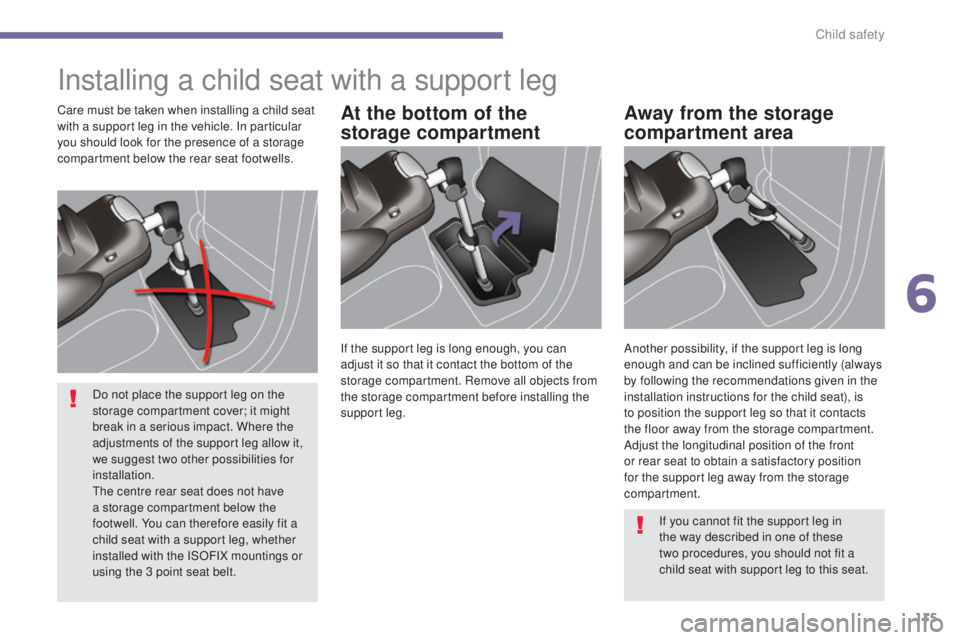
115
3008_en_Chap06_securite-enfants_ed01-2015
Installing a child seat with a support leg
At the bottom of the
storage compartmentAway from the storage
compartment areaCare must be taken when installing a child seat
with a support leg in the vehicle. In particular
you should look for the presence of a storage
compartment below the rear seat footwells.
Do not place the support leg on the
storage compartment cover; it might
break in a serious impact. Where the
adjustments of the support leg allow it,
we suggest two other possibilities for
installation.
The centre rear seat does not have
a storage compartment below the
footwell. You can therefore easily fit a
child seat with a support leg, whether
installed with the ISOFIX mountings or
using the 3 point seat belt. If you cannot fit the support leg in
the way described in one of these
two procedures, you should not fit a
child seat with support leg to this seat.
If the support leg is long enough, you can
adjust it so that it contact the bottom of the
storage compartment. Remove all objects from
the storage compartment before installing the
support leg.
Another possibility, if the support leg is long
enough and can be inclined sufficiently (always
by following the recommendations given in the
installation instructions for the child seat), is
to position the support leg so that it contacts
the floor away from the storage compartment.
Adjust the longitudinal position of the front
or rear seat to obtain a satisfactory position
for the support leg away from the storage
compartment.
6
Child safety
Page 118 of 344
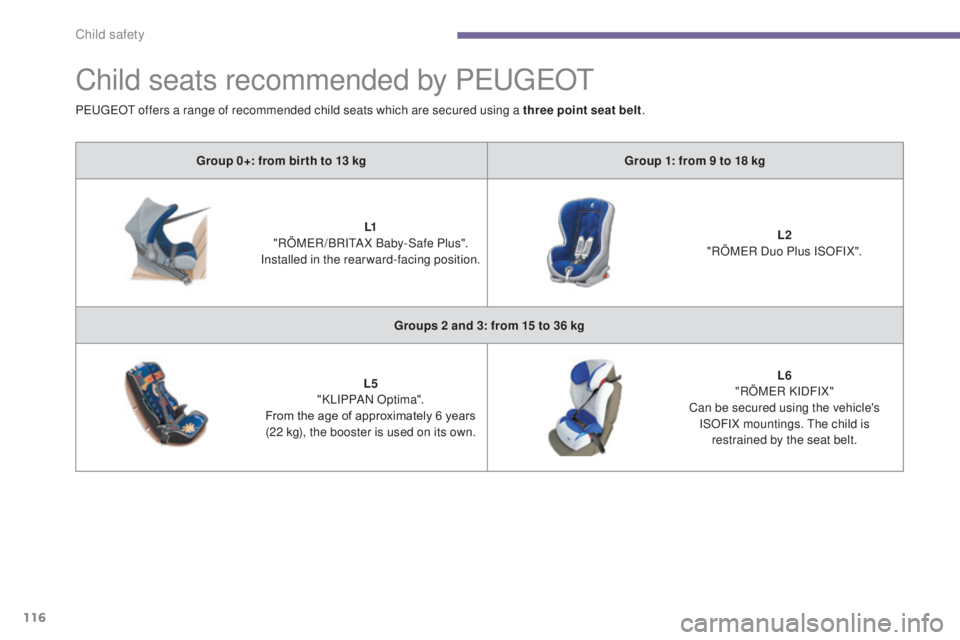
116
3008_en_Chap06_securite-enfants_ed01-2015
Child seats recommended by PEUGEOT
Group 0+: from bir th to 13 kgGroup 1: from 9 to 18 kg
L1
"RÖMER /BRITA X Baby-Safe Plus".
Installed in the rearward-facing position. L2
"RÖMER Duo Plus ISOFIX".
Groups 2 and 3: from 15 to 36 kg
L5
" K LI PPA N O pt ima".
From the age of approximately 6 years
(22 kg), the booster is used on its own. L6
"RÖMER KIDFIX"
Can be secured using the vehicle's ISOFIX mountings. The child is restrained by the seat belt.
PEUGEOT offers a range of recommended child seats which are secured using a three point seat belt
.
Child safety
Page 119 of 344
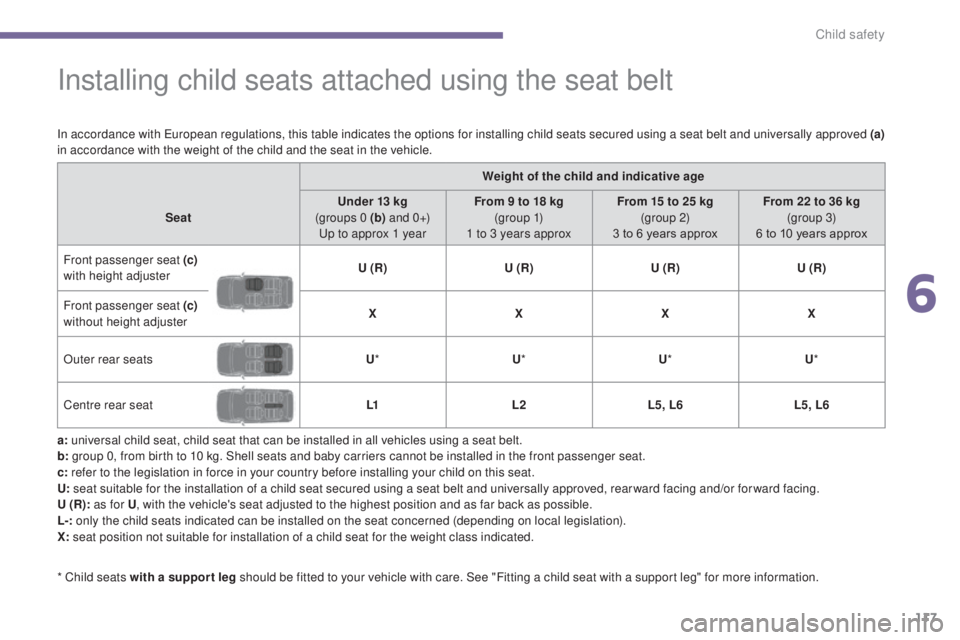
117
3008_en_Chap06_securite-enfants_ed01-2015
Installing child seats attached using the seat belt
a: universal child seat, child seat that can be installed in all vehicles using a seat belt.
b: group 0, from birth to 10 kg. Shell seats and baby carriers cannot be installed in the front passenger seat.
c: refer to the legislation in force in your country before installing your child on this seat.
U: seat suitable for the installation of a child seat secured using a seat belt and universally approved, rear ward facing and/or for ward facing.
U (R): as for U , with the vehicle's seat adjusted to the highest position and as far back as possible.
L-: only the child seats indicated can be installed on the seat concerned (depending on local legislation).
X: seat position not suitable for installation of a child seat for the weight class indicated.
In accordance with European regulations, this table indicates the options for installing child seats secured using a seat belt and universally approved
(a)
in accordance with the weight of the child and the seat in the vehicle.
* Child seats with a support leg should be fitted to your vehicle with care. See "Fitting a child seat with a support leg" for more information. Weight of the child and indicative age
Seat Under 13 kg
(groups 0 (b) a n d 0 +)
Up to approx 1 year From 9 to 18 kg
(g r o u p 1)
1 to 3 years approx From 15 to 25 kg
(group 2)
3 to 6 years approx From 22 to 36 kg
(group 3)
6 to 10 years approx
Front passenger seat (c)
with height adjuster U (R)
U (R)U (R)U (R)
Front passenger seat (c)
without height adjuster X
XXX
Outer rear seats U* U* U* U*
Centre rear seat L1L2L5, L6 L5, L6
6
Child safety
Page 120 of 344
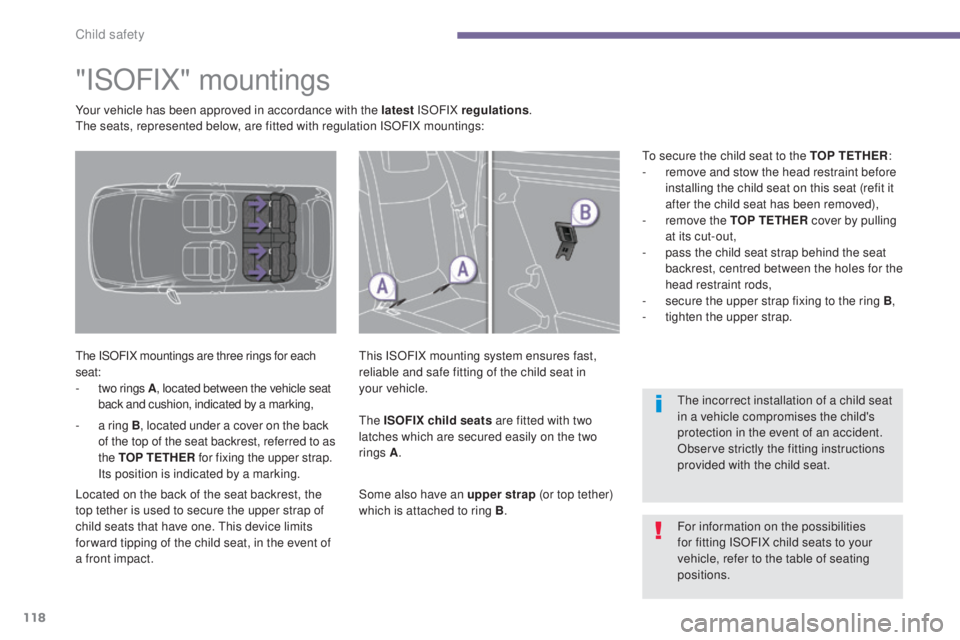
118
3008_en_Chap06_securite-enfants_ed01-2015
"ISOFIX" mountings
The ISOFIX mountings are three rings for each
seat:
-
t
wo rings A, located between the vehicle seat
back and cushion, indicated by a marking, This ISOFIX mounting system ensures fast,
reliable and safe fitting of the child seat in
your
vehicle.
The ISOFIX child seats are fitted with two
latches which are secured easily on the two
rings A .
Some also have an upper strap (or top tether)
which is attached to ring B .To secure the child seat to the TOP TETHER
:
-
r
emove and stow the head restraint before
installing the child seat on this seat (refit it
after the child seat has been removed),
-
r
emove the TOP TETHER cover by pulling
at its cut-out,
-
p
ass the child seat strap behind the seat
backrest, centred between the holes for the
head restraint rods,
-
s
ecure the upper strap fixing to the ring B
,
-
t
ighten the upper strap.
Your vehicle has been approved in accordance with the latest ISOFIX
regulations.
The seats, represented below, are fitted with regulation ISOFIX mountings:
-
a r
ing B, located under a cover on the back
of the top of the seat backrest, referred to as
the TOP TETHER for fixing the upper strap.
I
ts position is indicated by a marking. For information on the possibilities
for fitting ISOFIX child seats to your
vehicle, refer to the table of seating
positions. The incorrect installation of a child seat
in a vehicle compromises the child's
protection in the event of an accident.
Observe strictly the fitting instructions
provided with the child seat.
Located on the back of the seat backrest, the
top tether is used to secure the upper strap of
child seats that have one. This device limits
for ward tipping of the child seat, in the event of
a front impact.
Child safety